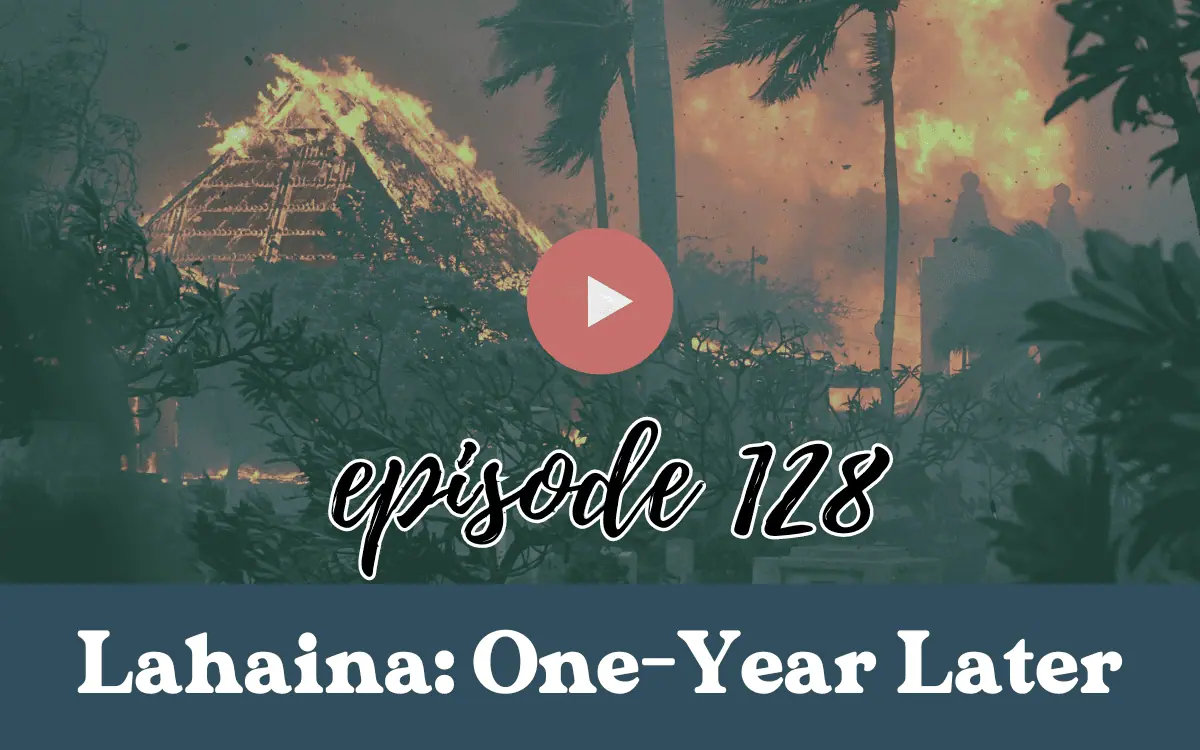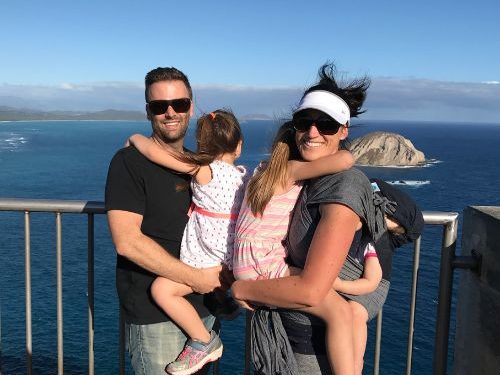Ep 128: One Year After Lahaina Wildfire: Progress, Challenges, and Hope

Today marks a poignant chapter in Hawaii’s history—one year after the devastating wildfires that reshaped Lahaina, the once vibrant capital of all of Hawaii.
On August 8, 2023, a catastrophic fire claimed over 100 lives, destroyed more than 2,200 structures, and displaced roughly 12,000 residents.
Join me as we delve deep into the heart and soul of our beautiful islands to bring you stories of culture, adventure, resilience, and the profound journey of Lahaina’s people toward recovery.
This post gives general info and isn’t legal or authoritative advice. It helps travelers with tips but can’t replace personal abilities, fitness, experience, or local knowledge. Marine activities have risks; assess conditions and follow local laws.
The Immediate Aftermath and Our Community’s Response
The fires left Lahaina unrecognizable, turning lively streets into ashes. Yet, in this harrowing time, the spirit of Maui’s people shone brightly.
Local heroes and organizations like the American Red Cross provided essential aid, but it was the determination and quick action of our residents that truly made a difference.
They rallied together, proving our community’s heart beats stronger than ever in times of crisis. This episode is not just a reflection; it’s a tribute to their unbreakable spirit.
Personal Reflections on the Tragic Day
Reflecting on that tragic day brings back a flood of emotions. Like many of you, I first learned of the disaster through social media.
The magnitude of the devastation was overwhelming, similar to the disbelief we all felt during events like 9/11. Yet, amidst this chaos, there was a relentless pursuit of survival and resilience that filled our community, a story that needs to be told and remembered.
Celebrating Our Heroes and Their Tireless Efforts
This episode and post honor those who faced unimaginable challenges head-on. We share stories like that of Kawena Kahula, a survivor and Lahaina evacuee, whose harrowing escape exemplifies the bravery and quick thinking of our people.
It’s crucial to recognize and support these heroes as they continue their journey of recovery.
Lahaina’s Path to Recovery
Over the past year, Lahaina has made significant strides in recovery. The cleanup, led by the Army Corps of Engineers, and the rebuilding efforts are just the beginning. Temporary housing projects have provided some normalcy to those who lost everything.
Yet, the road to full recovery remains long, with numerous challenges including legal, logistical, and emotional hurdles still to overcome.
How You Can Actively Participate in Lahaina’s Recovery
Here’s how you can help:
- Support Local Organizations: Contribute to groups like the Maui Strong Fund, pivotal in the recovery process. Every donation helps families rebuild their lives.
- Volunteer: Engage with community-led rebuilding projects. If you’re visiting Maui or are local, your hands and hearts are needed on the ground.
- Stay Informed: Understanding the challenges and progress in Lahaina helps foster a knowledgeable and supportive community.
Looking Ahead: Prevention and Policy
Reflecting on last year’s tragedy, we discuss the lessons learned and steps being taken to prevent future disasters. Enhancing local firefighting resources, improving evacuation procedures, and using fire-resistant materials in new constructions are crucial. Residents also advocate for stronger policies on emergency response and disaster preparedness at both the local and state levels.
Wrap-Up
Reflecting on one year since the devastating fires, the story of Lahaina is one of heartbreak and hope. As we support and rebuild, let’s carry forward the lessons learned to ensure our community emerges stronger and more resilient. Your engagement, whether through direct support or by sharing these stories, fuels our collective recovery.
Listen On:
Resources
Links and Media from This Episode…
- Aina Momona
- Maui Strong Fund
- Volunteer on Maui
-
Opening Song: Lahaina Luna by Makaha Sons
Self-Guided Island Tours
Travel Pono (responsibly)
- Pono Pledge Website
- Episode 70 – How to Volunteer in Hawaii
- Episode 87 – How to Travel Responsibly to Hawaii
Connect With Us
- Buy Me a Coffee
- Send Us a Message with any questions about Hawaii
- Hawaii’s Best Instagram
- Join our Hawaii’s Best Travel Facebook group here now! It’s the perfect place to ask any questions and to be inspired!
Bumper music, Ukulele and Chill, provided by Coby G (used with permission)
Bumper music, Aloha Friday, provided by Clay D (used with permission)
Spread Aloha
- Leave an honest review and follow us on Apple Podcasts
Related Episodes
Ep. 188: 9 Hawaii Travel Hacks That Actually Work in 2025
Planning a trip to Hawaii means sorting through endless advice online. Most of it? Recycled tips that sound good but don't deliver. I've spent years helping travelers experience Hawaii authentically, and I'm sharing nine proven Hawaii travel hacks that will save you...
Ep. 187: 25 Best Local Restaurants on Maui You Can’t Miss
Are you tired of overpriced tourist traps and wondering where locals actually eat on Maui? You're not alone. Most visitors stick to resort restaurants or fall for tourist-focused spots that drain your wallet without delivering authentic Hawaiian flavors. I recently...
How Will the 2025 Federal Shutdown Affect Your Hawaii Trip?
Will the federal government shutdown affect your Hawaii trip? That's the urgent question thousands of travelers are asking right now as headlines create confusion about what's actually open and what's closed.If you're planning a Hawaii vacation or currently on the...
Transcript
128_Lahaia 1 Year_01
[00:00:00] Lahaina used to be the capital of all of Hawaii. All the places that are tourist areas that are Hawaiian history are gone. And that can’t be replaced. You can’t refurbish a building that is just ashes now. You know, it can’t be rebuilt. It’s lost forever. Welcome to a special episode of Hawaii’s Best.
[00:00:20] Today we’re reflecting on a pivotal moment in Hawaii’s history. It has been exactly one year since the devastating fires that destroyed the historic town of Lahaina, leading to one of the deadliest natural disasters in recent U. S. history. On August 8th of 2003, Lahaina was struck by a catastrophic fire that claimed over 100 lives, destroyed more than 2, 200 structures, and displaced approximately 12, 000 residents.
[00:00:48] In the immediate aftermath, the community rallied to support the displaced and bereaved. The landscape of Lahaina has forever been changed. The streets, once vibrant with life, were reduced to ashes. However, the spirit of Maui remained unbroken, and this past year has been a testament to the resilience of its people.
[00:01:09] Today, we’ll give you an update on the recovery efforts that have unfolded since this tragedy. This episode is dedicated to the people of Lahaina, Those who have survived, those who are rebuilding and those who are remembered. I’m home to the island,
[00:01:32] to
[00:01:35] LA
[00:01:40] where the mountain are green, you’ll.
[00:01:57] I remember early on August 8th, hearing reports of fires on Maui and didn’t think much of it. And then later in the evenings, I just, I completely switch off. I turn off, I go airplane mode and you know, I’m not on the screens, I’m not watching TV or anything like that. So I didn’t see anything about the Lahaina fires until the morning of August 9th.
[00:02:19] And I opened up my Instagram account and just seeing. Probably like you, this flood of images and videos of what had happened and what is currently happening. And it was just, it was just disbelief. Like it was like, what do you mean? Like Lyanna’s gone on a different level. Reminded me of 9 11, meaning I remember going to a college class that morning.
[00:02:45] And it was on the TV in the classroom and I was like, what do you mean the towers are gone? It was one of those disbelief moments. Like you can’t, you can’t believe that happened. Like that actually happened. And I think for myself and probably you and a lot of people, it was just this utter disbelief. But in that disbelief, there were.
[00:03:05] People trying to survive, trying to get basic necessities in that moment. And today I want to honor that and share some of their stories and also want to give an update on ways that we can all continue to help support and come alongside of the community of Lahaina. In the critical hours and days that followed August 8th, the community and the world’s response was critical.
[00:03:31] The scale of the emergency required a massive coordinated effort, one that didn’t take shape fast enough. And the efforts of the American Red Cross, along with other humanitarian organizations, played a role in providing immediate assistance. They offered food, water, medical care, ensuring that those affected had access to basic necessities in the wake of the disaster.
[00:03:53] However, with government assistance not arriving until a full two days after the fire, it was the grit and determination of the local community of Maui that were the true heroes. Here’s what Kawena Kahula, a survivor in Lahaina evacuee, had to say. You had no idea that as you were evacuating, you were actually heading into the firestorm.
[00:04:15] I didn’t know. I didn’t know until there was big black mushroom clouds of smoke continuing to stack up on each other. bigger and bigger. Was th in these first few hours No, nothing. When was the to see the government ste of those basic necessities It started to sound like conversations based on th information and social me YouTube and news, you know, it’s from what it sounded like the community took it into their hands first.
[00:04:59] Are you a first responder? No. You have no experience responding to natural disasters? No. You’re telling me you were able to make it out of that area and yet food was not able to make it in, food delivered by the government? Yes. I wanted to share this raw clip because it’s important to remember the stories and the people in Lahaina that actually went through this disaster firsthand.
[00:05:26] As the immediate threat subsided, the focus shifted to assessing the damage and the wildfires had left a significant mark. Over 2200 structures were damaged and destroyed and the landscape of Lahaina was completely devastating. So, in the wake of this, the community faced the immense task of cleaning up and planning for what was next.
[00:05:48] And over this past year, Lahaina has seen some strides in rebuilding and reopening some spots, yet the road to full recovery remains a long and complex one. The cleanup operations led by the Army Corps of Engineers is a massive undertaking. They have removed hundreds of thousands of tons of debris from destroyed homes and businesses.
[00:06:09] For And this cleanup has been critical in paving the way for what is next and the next steps of rebuilding. Reconstruction efforts have begun with the landscape of Lahaina gradually changing once again. And around June of this year, 2024, the first signs of rebuilding started. The government also initiated several temporary housing projects to accommodate those who lost their homes.
[00:06:35] These projects have provided a critical role in providing some form of normalcy for hundreds of families. However, the challenges are substantial and legal and logistic delays have complicated the efforts. For instance, the plan to establish a permanent disposal site for the fire debris phase setbacks, which highlighted the complex interplay of environmental concerns and recovery needs.
[00:06:59] Additionally, there is a significant emotional and psychological toll on the residents. So rebuilding isn’t just about structures, it’s about restoring the community spirit and assessing the mental health needs of those affected. So support services and community initiatives have been instrumental in this aspect, helping to weave back the social fabric of Lahaina.
[00:07:19] As Lahaina’s journey to recovery is ongoing, it’s essential to focus on the remarkable resilience and support within the community. Spirit of Lahaina has shown incredible strength and unity in the face of adversity. Organizations such as Maui Strong Fund spearheaded fundraising and relief efforts providing much needed support to those affected.
[00:07:39] Also, there was a massive push and campaign for GoFundMes and Venmo accounts. Those are ways that people can People were able to directly help and support those impacted on the ground in Lahaina. And one of the ones was actually, I follow this guy, I saw an Instagram post. And one of the things in the media was I saw this guy who is a mobile auto repair guy, and he had a Venmo.
[00:08:06] For asking for gas he was, you know, driving in and out helping people get them supplies And that was one of the things that we were able to help donate and support was just paying for gas Through this guy’s demo account. So there’s a lot of those things those grassroots Efforts that came into play and then there was you know organizations such as maui strong fund who are still doing Great work and they provide a much needed support to those affected You These initiatives have been critical in helping families rebuild their lives and businesses.
[00:08:38] And last year around late August, we had on few of those businesses that were affected by the fires. You can go back. We’ll link them below some of those episodes. It’s interesting to hear their story. Some. businesses that were in Lahaina and lost businesses due to the fires and others on the other side of the island of Maui and how they helped play a critical role in helping support their local community.
[00:09:06] As Lahaina looks ahead, the focus is a long term rebuilding and preventative strategies. Obviously, the lessons learned from last year’s wildfires are being At least I hope they are into the planning and development to prevent such future devastating losses in the future. This includes enhancing firefighting resources, improving evacuation procedures, and incorporating fire resistant materials and designs in new constructions.
[00:09:33] Investments are also being made in environmental restoration, the restoration of native forests. Vegetation and the implementation of better land management practices are critical in reducing the risk of future wildfires. These efforts also play a vital role in preserving Maui’s unique ecosystem in biodiversity.
[00:09:52] In addition to this, the community is advocating for stronger policies on emergency response and disaster preparedness at both the local and state levels of Hawaii. So it’s clear that. While much has been accomplished, the road ahead still requires our collective support and action. And for those looking to contribute to Lahaina’s ongoing recovery, there are numerous ways to get involved.
[00:10:15] Donations can be made to local organizations like Aina Mauna and Maui Strong Fund, which continue to provide essential support to affected families and businesses. Also, volunteering your time and skills can make a significant difference while visiting any of the islands in Hawaii, especially Maui. It’s all of our support that helps to continue to make a difference in the lives of those affected by last year’s wildfires.
[00:10:39] For ways to give and volunteer, you can visit hawaiisbesttravel. com slash 1 2 8 1 28. All right, until next time, my friends, be well. Aloha. Mahalo for listening to this episode of Hawaii’s Best. To stay up to date on future episodes, please subscribe and visit us at hawaiisbesttravel. com.
Bryan Murphy is the creator of Hawaii’s Best Travel and a Certified Hawaii Destination Expert through the Hawai‘i Visitors Bureau. He’s an active member of the Hawai‘i Visitors and Convention Bureau and continues ongoing education focused on Hawaiian culture, history, and sustainable travel. As the host of the “Hawaii’s Best Travel” podcast—one of the top travel podcasts in the U.S.—Bryan shares practical, respectful guidance to help visitors experience Hawai‘i in a more meaningful way. His work reaches nearly half a million people across podcast, blog, and social media.










